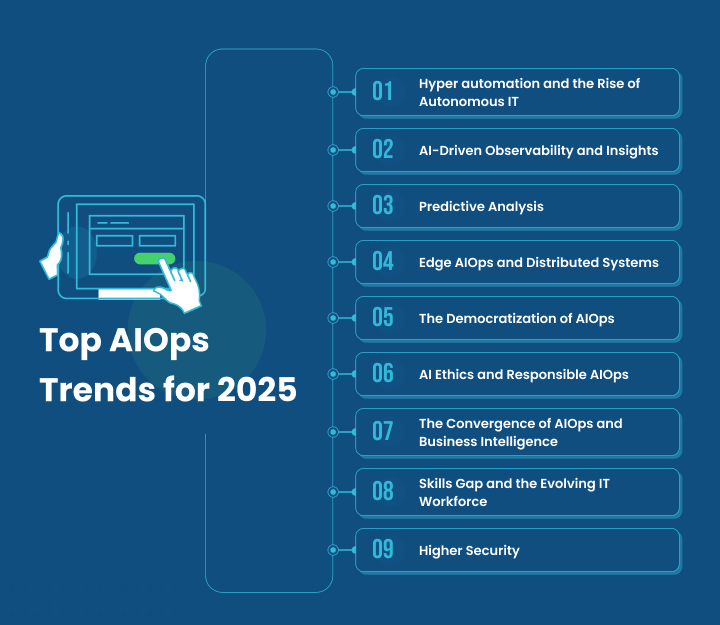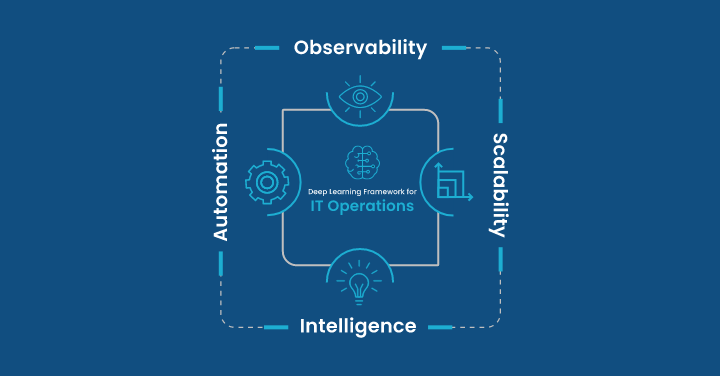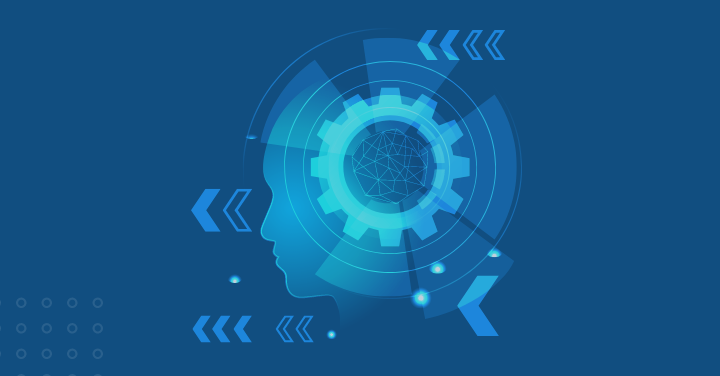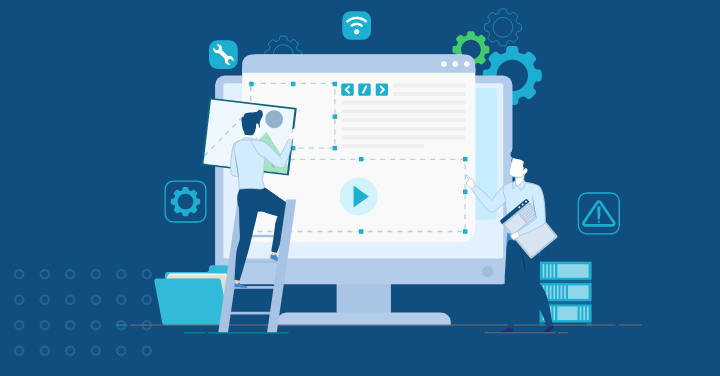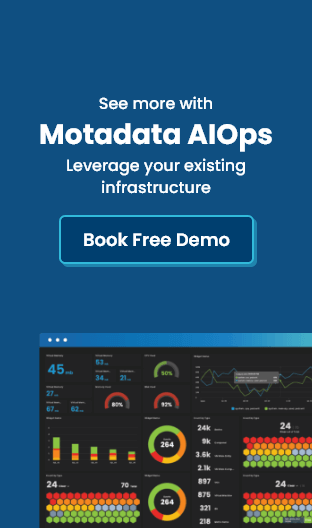Gartner introduced the word ‘AIOps’ back in 2017, and ever since, enterprises have been adapting to various strategies to streamline their IT operations.
AIOps is a successful venture because it meets the challenges and tackles the amount of data created in the tech infrastructures amid complex architectures.
As businesses are already adopting the revolutionized digital transformation, one must stay ahead and keep up with the latest AIOps trends.
AIOps helps enterprises meet the latest challenges and stand firm amid the market.
Growing With AIOps
It was mandated to adapt to new technologies such as AI and ML.
And with the caliber of AIOps, it will always be among the discussions when people talk about digital transformation and IT operations.
Gartner predicts that large enterprises’ exclusive use of AIOps and digital experience monitoring tools to monitor applications and infrastructure will rise from 5% in 2018 to 30% in 2024.
IT leaders are opting to embed AI and ML into IT operations and marketing, sales, and security.
And with everything becoming digital, the operations are becoming too challenging and complex to execute with traditional approaches.
This is one reason AIOps was trending this year, as many organizations got on board with robust AIOps solutions.
What is AIOps?
As coined by Gartner, AIOps stands for artificial intelligence for IT operations.
AIOps refers to applying AI capabilities like machine learning models and natural language processing to automate and streamline operational processes.
AI is the key player in IT operations functions like event correlation and anomaly detection since it can analyze vast volumes of data and networks to identify patterns, the root causes of the problem, and ways to prevent disruptions.
What are AIOps trends?
AIOps trends encompass the adoption of machine learning and automation in IT operations.
These trends are driven by the need for sophisticated tools that offer predictive analytics and root cause analysis.
Additionally, integration with DevOps and cloud computing is becoming increasingly important in the realm of AIOps.
Why is AIOps important?
Modern technology setups are becoming really complex. We have data environments like microservices, different cloud systems, and containers that work together.
This complexity generates a lot of data, like logs and performance information.
Such data can be too much for people to handle, making it hard to understand if everything works well and safely.
AIOps can set the stage here by efficiently monitoring networks, ensuring complete visibility into the IT systems’ dependencies, both internal and external, and even supporting tasks like learning how to use digital signage effectively within complex environments.
And the best thing is that an AIOps solution can do this without human input.
Here are some reasons why an AIOps solution is a good choice for enterprises:
- Automate problem detection and diagnosis, resulting in quicker resolution and reduced downtime.
- Data-driven insights that help you make wise decisions related to resource allocation and performance optimization.
- Predicts and prevents IT issues by identifying patterns and addressing problems before they become disruptive.
- Leverage predictive analysis for forecasting future trends and potential concerns.
- Find out the root causes of the issues by evaluating data from various apps, systems, etc., thus reducing the time spent on manually identifying the cause.
What are the Recent Technological Advancements in AIOps
Recent technological advancements in AIOps have significantly enhanced IT operations functions, including event correlation capabilities and the ability to analyze event data.
These advancements leverage predictive analytics, AI-driven observability, and anomaly detection to identify issues before they impact performance proactively.
By integrating machine learning algorithms with historical data patterns from diverse sources such as cloud infrastructure and application logs, as well as machine data, AIOps platforms provide real-time insights into system performance.
They enable operations teams to address issues swiftly, improving response times and user experience.
These advancements streamline incident management, reduce mean time to resolution, and empower IT teams with actionable insights for better decision-making.
Top AIOps Trends for 2025:
AIOps is not just a dream for the future anymore; it is real and changing IT operations now and in the future. By 2025, a few key trends will push the growth of the AIOps platform market and major effects of AIOps.
With smooth connections to current IT processes and better automation features, AIOps will change how IT teams work. It will boost their efficiency, agility, and creativity. As companies aim for better performance in a more complicated tech world, knowing and accepting these key trends will be very important for their success.
Trend 1: Hyperautomation and the Rise of Autonomous IT
Amid the evolving landscape of AIOps, Trend 1 focuses on Hyperautomation and the ascent of Autonomous IT. This trend signifies a pivotal shift towards automated processes and self-managing IT systems leveraging artificial intelligence.
Hyperautomation streamlines complex tasks by integrating advanced technologies like machine learning and predictive analytics.
The trajectory towards Autonomous IT heralds a future where IT systems proactively adapt and optimize themselves, reducing reliance on manual intervention and enhancing operational efficiency. This automation wave is set to revolutionize IT operations profoundly.
Trend 2: AI-Driven Observability and Insights
AI-driven observability and Insights in AIOps involve leveraging artificial intelligence for granular visibility into IT systems.
By employing predictive analytics and machine learning, organizations can proactively identify performance issues before they escalate, leading to a more resilient and efficient IT infrastructure.
This trend enhances anomaly detection and Root Cause Analysis, enabling faster resolution of incidents and optimizing system performance.
AI-driven insights provide real-time data analytics, empowering IT operations teams to make informed decisions promptly based on actionable insights derived from vast volumes of historical and raw data as well as real-time data.
Adaptive observability, applied to tasks like digital signage installation, ensures real-time monitoring and proactive issue resolution, enhancing efficiency.
This trend significantly improves operational efficiency and user experience.
Trends 3: Predictive Analysis
In 2025 and beyond, we can expect a considerable focus on predictive analysis in AIOps.
The predictive analysis benefits from historical and real-time data and identifies anomalies, patterns, and correlations.
AIOps solutions with predictive analysis can proactively identify and alert enterprises to potential problems by evaluating data, ensuring a proactive and resilient IT landscape.
Predictive analysis in AIOps cuts down operational costs, prevents downtime, optimizes resource allocation, and lets IT teams focus on more strategic tasks.
The growing complexity of IT environments makes the proactive prevention of issues now more important than ever.
Trend 4: Edge AIOps and Distributed Systems
Incorporating Edge AIOps and Distributed Systems in IT operations is on the rise.
This trend focuses on optimizing performance monitoring and incident management in decentralized environments.
By leveraging AI and predictive analytics at the network edge, organizations can proactively identify and address potential problems before they impact the core IT systems.
The combination of real-time data analytics and AI-driven insights enables swift responses to issues, enhancing operational efficiency and user experience in distributed IT environments.
Trend 5: The Democratization of AIOps
With the democratization of AIOps, accessibility to advanced analytics and actionable insights is widening across various sectors.
This trend empowers teams to leverage AI and ML capabilities without extensive expertise, enabling a unified approach to IT operations.
By democratizing AIOPS platforms, organizations can drive better business outcomes and address issues proactively.
This evolution reduces the dependency on specialized IT teams, fostering a culture where operational data and AI-driven decision-making are democratized for enhanced efficiency and performance.
Trend 6: AI Ethics and Responsible AIOps
AI Ethics and Responsible AIOps delve into the ethical implications surrounding AI technologies in IT operations.
Ensuring transparency and accountability in AI algorithms is crucial to maintaining trust and credibility.
Organizations can mitigate biases, promote fairness, and uphold data privacy by implementing ethical guidelines and frameworks.
Responsible AIOps practices involve continuous monitoring and evaluation to safeguard against unintended consequences.
Striking a balance between innovation and ethical considerations is paramount for the sustainable advancement of AIOps technologies.
Incorporating ethical principles into AIOps frameworks fosters a more responsible and trustworthy IT landscape.
Trend 7: The Convergence of AIOps and Business Intelligence
By 2025, one of the significant trends shaping IT operations is the convergence of AIOps and Business Intelligence.
This merging allows for a unified approach in leveraging data analytics services to drive business outcomes.
AIOps systems are being enhanced with advanced analytics and predictive capabilities from Business Intelligence.
This convergence enables IT teams to make informed decisions based on actionable insights derived from vast data volumes, streamlining operations and improving overall business efficiency.
Trend 8: Skills Gap and the Evolving IT Workforce
With the rapid evolution of AIOps, the demand for specialized skills in IT operations is intensifying. As technology advances, the IT workforce must adapt to harness the full potential of AI-driven solutions.
Bridging the skills gap is crucial to effectively meet the evolving demands of managing complex IT systems.
Organizations need to invest in upskilling their teams to leverage AIOPS platforms efficiently.
Embracing this trend will empower IT professionals to navigate the ever-changing landscape of IT operations.
Trends 9: Higher Security
An IBM survey says that over 4,000 EU, US, and Chinese businesses opted for AI implementation because of the cyber security it offers.
The fear of security breaches and malware attacks increases with the more prominent and complex architectures.
Many experts see using AIOps in enterprises as the next big thing in cyber security.
As AIOps learns from human behavior and previous breaches, it prevents any upcoming potential violations as well. And any business would opt for a secure infrastructure. Hence, it trended this year.
Facebook came up with Metaverse, introducing new technologies and increasing investment in cryptocurrencies, raising many fresh security concerns.
And AIOps come to the rescue, securing the operations like never.
AIOps Market and Growth
It wasn’t just the AI capabilities that grew; the players themselves, AIOps solution providers, also became competitive.
Processing the different kinds of data helped the service providers stand firm and distinguish themselves in the market.
It was predicted back in 2020 by Mordor Intelligence that the AIOps market would grow from 13.51$ billion in 2020 to over 40$ billion by 2026.
And the way modern organizations and enterprises continue to adopt such technologies would take less time to achieve the fit.
AIOps powered by Motadata is a powerful solution that caters to market challenges and customer needs.
The solution is designed with AI and ML technologies, offering rich abilities and keeping you stand firm in the market.
Feel free to reach out to us at sales@motadata.com.
FAQs:
The biggest challenge to AIOps adoption is the integration of diverse data sources and legacy systems, ensuring accurate data quality and relevance. Overcoming resistance to change and upskilling staff are crucial hurdles for successful implementation.
Key metrics for measuring AIOps success include MTTR reduction, automation rate, anomaly detection accuracy, scalability impact, and cost savings. Monitoring these metrics ensures efficient AIOps implementation and performance optimization.
AIOps differs from traditional IT tools by leveraging AI and machine learning to automate and enhance IT operations, providing real-time insights, predictive analytics, and proactive problem resolution. This advanced approach improves efficiency, reduces downtime, and enables a more agile and responsive IT environment through the use of collaboration platforms.



